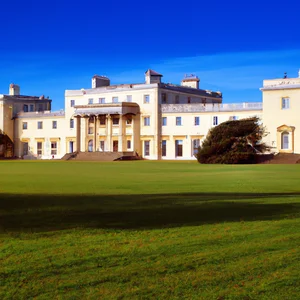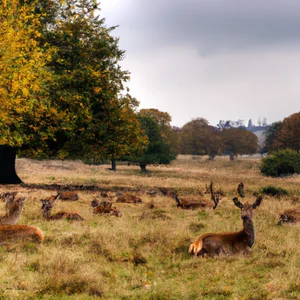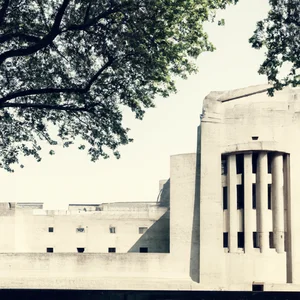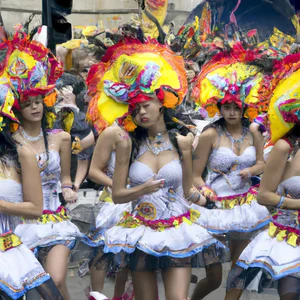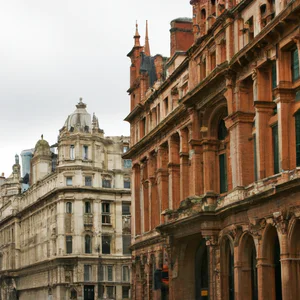Book your experience
Public toilets in London
So, let’s talk about public toilets in London, which is always a hot topic, right? I don’t know about you, but when I’m out and about in the city, finding a place to take a break is essential.
So, if you are in London and need a “pit stop”, here are some tips on where to turn. First of all, there are actual public toilets, which are usually found in parks or in some squares. But be careful, they are not always the cleanest places in the world, to be honest. I remember one time I went into one of these bathrooms in Hyde Park and, well, it wasn’t exactly five star, if you know what I mean.
However, there are also more “refined” options. Many malls, like Westfield, have bathrooms that almost look like hotel suites, complete with scented soaps and paper towels, not to mention they’re clean! So, if it escapes you and you’re nearby, don’t be shy and take advantage of it.
And then, there are the free bathrooms, which are a rarity, but not impossible to find. For example, some subway stations offer services without making you pay a penny. But, and here’s the kicker, they’re not always in great condition. In short, a bit like finding a needle in a haystack, but it’s worth trying!
If you’re out and about in Piccadilly Circus, keep an eye out for bars or restaurants. Many of them allow you to use the bathrooms, especially if you order a coffee or something to eat. It’s a trick I learned from a friend who lives there, and believe me, he has saved my tummy on many occasions.
In summary, public toilets in London can be an adventure in itself, a bit like a treasure hunt, and sometimes you will find yourself taking some strange turns before finding the right one. So, next time you’re in town and feeling stuck, don’t despair! With a little luck and a good sense of direction, you will surely find a decent bathroom to recharge your batteries. Oh, and don’t forget to always keep a pack of tissues handy, because you never know!
The best public toilets in London
A personal experience
I remember a rainy afternoon in London, while I was walking along the Thames with a friend. The gray colors of the sky seemed to reflect on the water, and after a couple of hours of exploring, we found ourselves in a common situation: the urgent need to find a public toilet. Luckily, we came across one of the best bathrooms in London, located inside Covent Garden tube station. This refuge not only offered us a moment of respite, but also introduced us to an experience that many tourists overlook: the quality and accessibility of public toilets in the British capital.
Public toilets not to be missed
London has plenty of well-maintained and conveniently located public toilets. Here are some of the best:
- Oxford Circus Station: A clean and spacious bathroom located in the heart of one of the busiest shopping districts. Perfect for a short break while shopping.
- St. James’s Park: Surrounded by nature, these baths are part of a historic green area and offer a peaceful atmosphere, away from the hustle and bustle of the city.
- Victoria Station: Here you will find modern and well-maintained services, open until late at night, ideal for those returning from an evening in the city.
An insider tip
A trick that few people know is that many museums and art galleries, such as the British Museum and the National Gallery, offer free, well-maintained public toilets. These places not only provide an essential service, but also offer the chance to explore extraordinary works of art while taking a break.
The cultural impact of public toilets
Public toilets in London are not only a practical need, but also an aspect of urban culture. Historically, these places have been fundamental to the well-being of citizens, helping to create spaces for socialization and interaction. Their presence has evolved the concept of public hygiene, changing the way Londoners interact with the city.
Sustainability and responsibility
In recent years, many public toilets in London have adopted eco-friendly practices, such as the use of eco-friendly soap dispensers and water-saving systems. Choosing to use these services is a small step towards more sustainable tourism.
An immersion in the atmosphere
Imagine walking into a public toilet in London: the smell of fresh soap, the gleaming white tiles and the sound of running water. Each bathroom has its own personality, and some even house works of art or historical decorations that tell the story of the city.
An activity worth trying
After visiting one of the public baths, why not treat yourself to a moment of relaxation in the nearby park? St. James’s Park, with its meandering paths and palace views, is the ideal place to refuel and enjoy London’s natural beauty.
Myths to dispel
A common misconception is that public toilets in London are dirty or unsafe. In fact, many of them are monitored regularly and offer a high standard of cleanliness and safety. It is important to know that, in general, bathrooms located in crowded places, such as stations and museums, tend to be the most well-kept.
Final reflection
Next time you’re in London, pop into one of its public toilets. Not only will you satisfy a practical need, but you will also have the opportunity to discover a unique and fascinating aspect of London life. What is your opinion on public toilets? Do you think they are just a necessary service or can they offer you a memorable cultural experience?
Free bathrooms: where to find them easily
During one of my walks along the lively streets of London, I found myself in a rather embarrassing situation: I had just enjoyed a delicious meal in a local pub, but the urgency of finding a bathroom was becoming more and more pressing. At that moment, I discovered a secret that every traveler should know: London offers numerous free public toilets, perfect for those who want to explore the city without worries.
Where to find them
The free public toilets in London are not only a godsend, but they are also more accessible than you think. Some of the best-known locations include:
- Public parks, such as Hyde Park and Regent’s Park, where you will find well-marked facilities.
- Tube stations, many of which offer free toilets, especially in main stations such as King’s Cross and Piccadilly Circus.
- Shopping centres, such as Westfield in Stratford, which have clean and easily accessible bathrooms.
For a complete and updated list, it is useful to consult the official website of the City of London or apps such as “Loo of the Year”, which indicate the nearest facilities.
An insider tip
Here’s a tip that few know: many restaurants and cafes in London are happy to allow access to their bathrooms, even if you’re not a customer. Don’t be afraid to ask, especially if the place is crowded. Remember, a smile and a “please” can open many doors!
A dive into history
London has a long and fascinating history of public toilets. During the 19th century, the city faced serious sanitation problems, which led to the implementation of public toilets. These places not only improved public health, but also became spaces for Londoners to socialize and meet.
Sustainability in public bathrooms
As environmental awareness increases, many establishments are adopting sustainable practices. For example, public restrooms in some parks use water-saving irrigation systems and eco-friendly soap dispensers. Choose to using these services not only helps you, but also contributes to responsible tourism.
Immerse yourself in the local atmosphere
When you enter a public toilet in London, it’s not just a time of necessity; it’s a little taste of daily life in the city. The conversations you hear, the smells and the sounds remind you that you are in a vibrant place, rich in history and culture.
Activities to try
Once you’ve refreshed your thoughts, why not take a walk in Hyde Park and enjoy a picnic? Bring a good read with you and take advantage of the relaxing atmosphere. And if you feel like exploring, check if there are any upcoming events or concerts; public toilets are often located within walking distance of cultural activities.
Myths to dispel
A common misconception is that public toilets in London are dirty or unsafe. In fact, many of them are very well maintained and checked regularly. Don’t let yourself be influenced by prejudices; a visit to one of these baths can be a surprisingly positive experience.
Final reflection
Next time you’re in London, consider how simple and liberating it can be to know where to find a free public toilet. Have you ever thought about how much these spaces represent a link between visitors and the daily lives of Londoners? The next time you enter one of these places, ask yourself: what stories could they tell?
How to use public toilets in London
I remember my first trip to London, when, after a long walk through the crowded streets of Covent Garden, I found myself in an embarrassing situation: the urgent need for a bathroom. Frantically looking for a place to escape, I discovered that London is full of public toilets, and using them can be as practical as it is fascinating.
Practical information
Public toilets in London are generally well signposted, especially in tourist areas. Many of them are managed by London Borough Council and are located in parks, squares and shopping centres. It’s important to note that while some are free, others may require a small fee, usually around 50p. Most of them are equipped with sinks and soap, with regular cleaning ensuring a dignified environment.
Unconventional advice
Here’s a trick that not everyone knows: many museums, such as the British Museum and the National Gallery, offer free and clean bathrooms, accessible even to non-paying visitors. These bathrooms are not only well maintained, but often also offer a peaceful atmosphere, away from the hustle and bustle of the streets.
The cultural impact
Public toilets in London are not just functional; they represent an aspect of the social and cultural history of the city. Originally, public toilets were conceived as spaces of social inclusion, where people of different classes and origins met. Today, they continue to reflect the diversity and vibrancy of the British capital.
Sustainability and responsibility
When using public toilets, it is important to adopt sustainable practices. Many bathrooms in London are equipped with water saving systems and use energy responsibly. Remember to use only the necessary toilet paper and not to waste water when washing your hands.
A vivid experience
Imagine entering a public toilet located in a park, surrounded by ancient trees and the fresh scent of grass. After freshening up your face, you look in the mirror and see not only your face reflected, but also a little piece of London’s history. Each bathroom has its own story to tell, a microcosm of experiences that intertwine and overlap.
Suggested activity
If you have some free time after using the public toilets, why not take a walk in the nearby parks? A great choice is Hyde Park, where you can enjoy a picnic or visit the monument to Diana, Princess of Wales, which is nearby.
Myths and misconceptions
A common misconception is that public bathrooms are dirty or unsafe. In fact, many toilets in London are kept in excellent condition and are located in very busy areas. It’s always a good idea to carry sanitary wipes or hand sanitizer with you, but don’t let the fear of using public restrooms ruin your experience exploring the city.
A new perspective
Next time you are in London and need a toilet, remember that you are entering a place that is much more than just a service. You’re accessing a piece of everyday London life, an opportunity to immerse yourself in the city’s culture and history. Have you ever wondered what stories the walls of a public bathroom could tell?
A cultural experience: the history of baths
I still remember my first visit to London, when, after a long walk through the Camden markets, I found myself looking for a public toilet. After asking a kind passerby for information, I headed towards an ancient red brick structure, which almost looked like a small museum. Upon entering, I was greeted not only by a sense of relief, but also by an atmosphere steeped in history. That little discovery kicked off my own exploration of the public baths of this extraordinary city, revealing fascinating stories and an often overlooked cultural heritage.
The history of public toilets in London
Public toilets in London have a history dating back to the Victorian era, when the city began to become sanitary conscious. In 1846, the municipal administration began the construction of public baths to improve the health of citizens and, since then, these structures have become a fundamental element of urban life. Today, London boasts a network of public toilets that not only serve as rest stops, but also tell stories of innovation and social progress.
An insider tip
If you are near Trafalgar Square, don’t forget to visit the public toilets located under the National Gallery. It may seem like a cliché, but what many don’t know is that these bathrooms were designed to reflect the neoclassical architecture of the area, making them a visual experience as well as a functional one.
Cultural impact and sustainability
The idea of public toilets is also a reflection of London culture: a way to promote inclusiveness and collective wellbeing. With the growing focus on sustainability, many public toilets in London are implementing eco-friendly practices, such as the use of biodegradable soaps and rainwater harvesting systems. These choices not only improve the user experience, but also help preserve the urban environment.
An experience worth trying
To enrich your visit, consider taking a walk in St. James Park and stopping at the public toilets there. Not only will you be able to refresh yourself, but you will also have the opportunity to immerse yourself in the serene atmosphere of the park, surrounded by well-kept gardens and stories of nobility that resonate in the wind.
Myths and misconceptions
There is a common misconception that public toilets are dirty or unsafe. In fact, London has made significant progress in maintaining and cleaning these facilities. Many public toilets are regularly monitored and maintained, ensuring a clean and welcoming environment.
Final reflection
As you explore London, take a moment to reflect on how these public spaces, often taken for granted, are actually a microcosm of the city’s history and culture. How about discovering a public toilet you’ve never noticed before? It could prove to be a fascinating corner of your London adventure.
Bathrooms historians: a dive into the past
A Personal Anecdote
When I first visited London, I found myself walking along the King’s Road, a vibrant and historic thoroughfare. My itinerary included a stop in one of the famous historic public baths, namely the Public Lavatory in Sloane Square. There, among the original mosaic tiles from the 1920s, I felt a connection to the city’s history, reflecting on how these spaces have served not only for daily needs, but also as meeting points in an era where public hygiene was a crucial issue.
Practical Information
London is dotted with historic public baths that tell fascinating stories. One of the best known is the Dulwich Park Public Toilet, built in 1890 and beautifully restored, offering not only basic amenities but also an old-world atmosphere. For the curious, London’s Public Toilets website provides a detailed map to locate these historic treasures, some of which are open 24 hours a day.
An Unconventional Advice
If you want an authentic experience, I recommend visiting the historic baths of Clapham Common, where you can find a small café next door serving tea and traditional cakes. Here, sitting with a cup of tea in hand, you can observe the daily life of Londoners, making your visit even more special.
Cultural and Historical Impact
Public baths played a vital role in improving public health in the 19th century. With the expansion of the city, these places became essential to guarantee hygiene and decorum. Today, visiting a historic public toilet is not just a practical act, but a way to connect with London’s fight for a healthier urban environment.
Sustainability and Responsibility
In an era where sustainability is key, many of these historic bathrooms have been repurposed with eco-friendly technologies, such as water-saving taps and LED lighting systems. Choosing to use these baths is not only a way to appreciate history, but also to support responsible tourism.
Immersion in the Atmosphere
Imagine entering a Victorian-era public restroom, with its shiny white tiles and high ceilings. The smell of fresh soap and the natural light streaming through the windows make you feel like you’ve stepped back in time. These places, often overlooked by tourists, offer a unique perspective on everyday life in London.
Recommended Activities
After exploring the historic baths, I recommend taking a walk in nearby parks, such as Hyde Park, where you can meditate on the city’s history and enjoy nature. You could also join a guided tour that includes stops at these historic baths for even more insight.
Myths and Misconceptions
It is often believed that public toilets are unhygienic and uncomfortable. However, many of these historic baths are maintained with great care and offer a clean and welcoming environment. Discovering the truth about these places can change your perception and make you further appreciate their historical importance.
Final reflection
Visiting a historic public toilet in London is more than just a practical gesture; it’s a way to immerse yourself in the culture and history of this extraordinary city. Have you ever wondered what stories the places we take for granted tell? Next time you’re in London, take a moment to explore one of these historic baths and let their history speak to you.
Unconventional tips for finding comfort in public toilets in London
During one of my aimless walks through the streets of London, I found myself in a rather embarrassing situation: in urgent need of a toilet and no premises in sight. After wandering around for a while, I discovered a little hidden corner, a public toilet located in a little-known, but incredibly well-kept park. This episode opened my eyes to the importance of knowing the hidden gems of the city, especially when it comes to finding comfort in public bathrooms.
Public toilets: where are they located?
London is a metropolis that offers a wide range of public toilets, but many tourists tend to only look for the most obvious options, such as those in large shopping centers or museums. However, there are many other possibilities. Here are some tips on where to find public toilets:
- Parks and gardens: Places like Hyde Park and Regent’s Park not only offer green spaces to relax, but also clean and well-maintained public toilets.
- Tube stations: Some larger stations, such as King’s Cross and Oxford Circus, have publicly accessible toilets.
- Libraries: Public libraries, such as the British Library, offer clean bathrooms and quiet spaces to rest.
An insider gem
Here’s a little-known tip: many public toilets in London are equipped with lockers and changing rooms. For example, London Fields Lido offers not only an outdoor swimming pool, but also well-equipped changing rooms. This is a great way to freshen up before continuing on with your London adventure. Don’t forget to bring a swimsuit!
A dive into history
Public toilets in London have a fascinating history. Originally, they were seen as an essential element of public welfare, dating back to the Victorian era. Their social and cultural importance is evident, as they not only provide a necessary service, but also serve as meeting points for communities. In recent years, many of these historic structures have been renovated to preserve their original charm, making them not only functional, but also an integral part of the local identity.
Sustainability in public bathrooms
In an age of growing environmental awareness, some public toilets in London are adopting sustainable practices. For example, many of them use water-saving systems and eco-friendly materials. This is a great sign of how the city is trying to reduce its environmental impact, while providing essential services to citizens and tourists.
An experience not to be missed
If you have time, visit the Pavilion Cafe in Victoria Park. Not only will you be able to enjoy great coffee and fresh pastries, but you will also find a very clean and welcoming public toilet. This cafe is a meeting point for locals and offers a lively and informal atmosphere.
It’s common to think that public bathrooms are dirty or uncomfortable, but the reality is often different. With a little research and knowledge, you can discover public toilets in London that are not only functional, but also an experience in themselves.
In conclusion, next time you are struggling to find a public toilet in London, remember that there are many options beyond the obvious ones. What has been your experience with public restrooms while traveling? Have you ever found an unexpected place that surprised you?
Sustainability: eco-friendly choices in bathrooms
When I first visited London, I remember being impressed by the variety of public toilets that could be found throughout the city. But what really surprised me was to discover that many of these spaces are embracing sustainable practices, an aspect that, although little known to tourists, is gaining more and more attention.
Public toilets and attention to the environment
In recent years, London has made great strides to improve the sustainability of its public toilets. For example, many of these have installed rainwater harvesting systems to supply toilets. Others use biodegradable products and recycled materials for maintenance. The city is also known for the “Clean Up UK” initiative, which aims to keep these essential spaces clean and efficient.
An example of eco-friendly public toilets is Victoria Embankment Gardens, where the facilities are equipped with LED lighting and eco-friendly soap dispensers. According to the official City of London website, this initiative has led to a significant reduction in waste and energy consumption.
Unconventional advice
A trick that only locals know is to check the bathrooms inside public libraries or museums. Not only are they often less crowded, but many of these places have also adopted sustainable practices, such as separate waste collection. Furthermore, a visit to a library or museum can prove to be a fascinating and enriching cultural experience.
The cultural context
The focus on sustainability in London’s public toilets reflects a wider shift in society, where citizens and visitors are increasingly aware of the environmental impact of their actions. These spaces are not just functional; they have become symbols of a collective commitment towards a greener future. The history of public toilets, in fact, is linked to moments of innovation and social reform, and today they also represent an opportunity to educate the public on sustainable practices.
Activities to try
While you’re exploring the city, why not take a walk in Royal Parks, such as Hyde Park or Kensington Gardens? Here you will find well-maintained public toilets, often equipped with green practices. You could also take advantage of this for a sustainable picnic, bringing along food from a local market and using reusable containers.
Myths to dispel
A common misconception is that public bathrooms are dirty or unsanitary. In fact, many London bathrooms are maintained to high standards of cleanliness and are equipped with eco-friendly products. Often, the idea that it’s a little scary to use public bathrooms is more a cultural legacy than a reality.
In conclusion, next time you visit London, consider using public toilets as an opportunity to explore not only the city, but also its commitment to sustainability. What will be your next eco-friendly bathroom to try?
The differences between public and private bathrooms
Imagine finding yourself in Piccadilly Circus, surrounded by dazzling lights and the buzz of crowds, after spending hours exploring shops and theatres. At some point, the need for a bathroom becomes pressing, but in a metropolis like London, the choice between a public and a private bathroom can significantly influence your experience. During one of my visits, I found myself in a similar situation and found that understanding the differences between these two types of toilets can be surprisingly helpful.
Public toilets: accessibility and practicality
Public toilets in London are designed to offer convenience and accessibility for all, with a network of facilities spread across the city, from parks to transport hubs. They are generally free and easily identifiable thanks to clearly visible signs. However, cleaning and maintenance may vary, so it is always advisable to have realistic expectations.
Private bathrooms: a moment of tranquility
In contrast, private bathrooms offer a more comfortable and often cleaner experience. These are found inside restaurants, cafes and shops. To access it, it is generally necessary to purchase something, but this can also become an opportunity to enjoy a coffee in a typical café. One tip I’ve learned over the years is to look for independent cafes or small chains - they often have well-maintained toilets and a welcoming atmosphere, perfect for a break.
An insider tip
A secret that few people know is that many museums in London, such as the British Museum and the National Gallery, offer free, impeccable public toilets. These places are not only clean, but also designated as quiet areas, allowing you to recharge your batteries in a stimulating and cultural environment. Don’t forget to take advantage of these facilities during your visit!
The cultural impact
The presence of public and private bathrooms reflects London’s culture of hospitality, where attention to the visitor’s well-being is always in the foreground. These spaces are not only functional, but also represent an aspect of urban life that facilitates exploration and enjoyment of the city. In a world increasingly attentive to sustainability, many factories are adopting eco-friendly practices even in their bathrooms, such as the use of biodegradable soaps and the implementation of water saving systems.
An invitation to explore
Next time you’re in London, take a moment to reflect on these differences. Experience a public toilet in a park and then take a break in a cafe with a private bathroom. These simple moments can enrich your tourist experience. And you, have you ever considered how the places where you stop for a need can influence your perception of a city?
In conclusion, next time you visit London, remember to take your time and not underestimate the importance of a good bathroom, be it public or private. It is not just a question of necessity, but also a way to immerse yourself in the local culture and discover hidden corners of the city. Have a good trip!
Authenticity: bathrooms frequented by locals
I still remember the first time I found myself in London, immersed in the frenetic pace of the city. After a long day wandering around the wonders of Camden Market, my body was screaming for help and I, with my heart in my mouth, was desperately looking for a bathroom. My adventure took me to a small family-run pub, not far from the market. Surprised by the friendliness of the bartender, I discovered that the bathroom, although modest, was a refuge used not only by tourists, but also by locals. That simple experience revealed to me how authentic and vital the public toilets frequented by Londoners can be.
Where to find them: the secret places of the locals
If you’re in London and need a bathroom, don’t limit yourself to the usual places. Here is a list of bathrooms that not only meet your needs, but also offer a taste of everyday London life:
- Pubs and cafes: Places like The Eagle in Camden or The Blackfriar offer clean and welcoming bathrooms. Don’t forget to order a beer or a coffee to feel part of the community.
- Markets: Markets such as Borough Market have toilets accessible to visitors. Here, you can also enjoy local culinary specialties while waiting for your turn.
- Libraries and community centres: Don’t underestimate libraries like the British Library, which often have clean toilets and are quiet, away from the crowds.
An insider tip
If you really want to immerse yourself in local culture, try visiting the bathrooms of some lesser-known museums, such as the Museum of London. Here, in addition to finding well-kept toilets, you can also enjoy the silent and contemplative atmosphere of the museum itself. And who knows? You might even discover some works of art that strike you!
The cultural impact of public toilets
Public toilets in London are not just a practical need; they are also a reflection of British culture. They offer a space for meeting and sharing, often becoming places of conversation between strangers. In the past, public toilets were a symbol of progress and urban hygiene, contributing to improving the living conditions of the population.
Sustainability and responsibility
When it comes to public toilets, sustainability is key. Many of the government-run toilets, such as those in parks are equipped with water saving systems. Make sure you turn off the tap while washing your hands: it’s a simple gesture that can make a difference in such a large city.
A lively and authentic experience
Imagine entering a crowded public restroom, surrounded by voices and laughter. It’s like a little microcosm of London life. In that moment, you may feel part of something bigger, a connection with the people around you. Public toilets, therefore, are not only functional, but can also offer you a unique experience if you are willing to get involved.
Final reflection
Next time you’re in London, remember that public toilets aren’t just a place to relieve a physiological need. They are an opportunity to discover the authenticity of London life. Have you ever thought about how interesting your trip could be, even to such a humble place?
Curiosity: toilets in London parks
I vividly remember my first afternoon spent in Hyde Park, immersed in the beauty of the gardens and ponds. After a long walk, with tired feet but an invigorated soul, a thought came to mind: “Where can I find a bathroom?” And so, with a bit of curiosity and audacity, I ventured towards one of the public toilets hidden among the trees, discovering a small corner of tranquility that exceeded my expectations.
Public restrooms in parks: an urban refuge
London offers several public toilets in its parks, and many of them are real treasures. Among the best known, we find the Hyde Park bathrooms, equipped with clean and well-maintained facilities, open every day from 9:00 to 18:00. Another great example is Regent’s Park toilet, which also boasts baby changing areas. Don’t forget to bring a £1 coin with you, as some toilets charge a small fee for use.
An insider tip
If you want to avoid long lines during rush hour, try visiting restrooms in smaller parks, like St. James’s Park. Here, you will find a less crowded and often more well-kept area. Furthermore, you will have the opportunity to explore the flower gardens and admire the swans on the lake. It is an experience that combines necessity and beauty!
The cultural impact of park bathrooms
Public toilets in London parks are not only a necessary service, but also an important aspect of London social life. These spaces have been designed to welcome residents and tourists, promoting access to adequate hygiene in leisure contexts. Furthermore, they offer a safe, clean haven in an often busy city, reflecting London’s commitment to sustainable and inclusive urban living.
Sustainability and responsibility
Many public toilets have recently been renovated with attention to ecology and sustainability. For example, using energy-efficient taps and collecting rainwater for cleaning are common practices. Choosing to use public toilets rather than café toilets helps reduce waste and promote a culture of respect for the environment.
An experience not to be missed
If you have time, after using the public toilets, take a break on one of the benches in Hyde Park with an ice cream from one of the nearby kiosks. Immerse yourself in the landscape, watching London life go by and pigeons wandering around looking for crumbs. It’s a perfect way to recharge your batteries and appreciate the beauty of London.
Myths to dispel
A common misconception is that public bathrooms are dirty or unsafe. In fact, many of them are maintained with great care and are checked regularly to ensure high standards of cleanliness. Don’t be intimidated: they are a fundamental part of the London experience and will allow you to explore the city without worries.
Reflecting on that afternoon in Hyde Park, I wonder: how many of us take the time to explore not only the monuments, but also the small, everyday details? Public toilets in London’s parks are not just an amenity, but an opportunity to connect with the city in a unique way. What is your experience with public toilets while travelling?

 Architecture and Design
Architecture and Design Cities and Regions
Cities and Regions Culture and History
Culture and History Events and Festivals
Events and Festivals Fashion and Shopping
Fashion and Shopping Food and Wine
Food and Wine Nature and Adventure
Nature and Adventure Unique Experiences
Unique Experiences


















